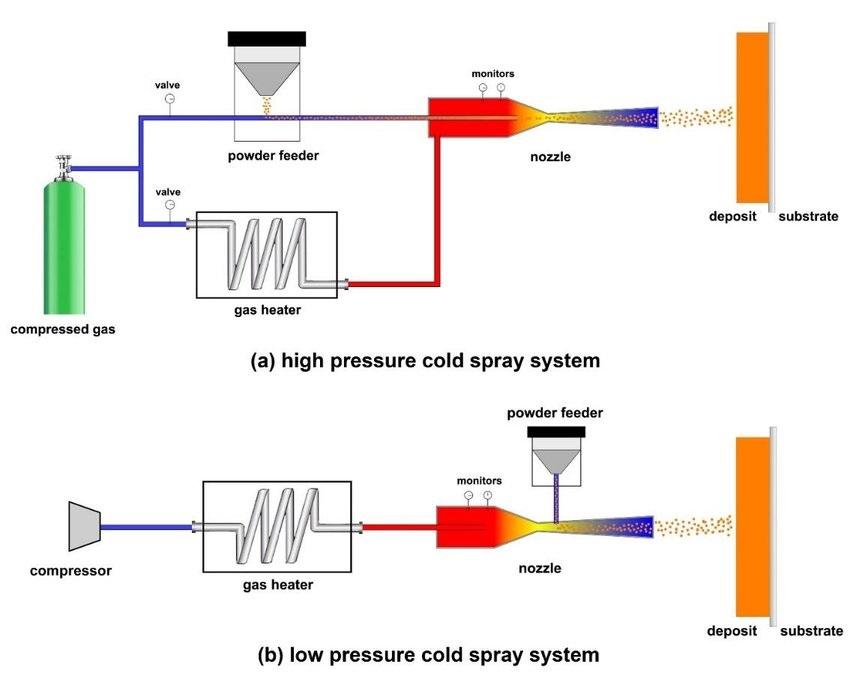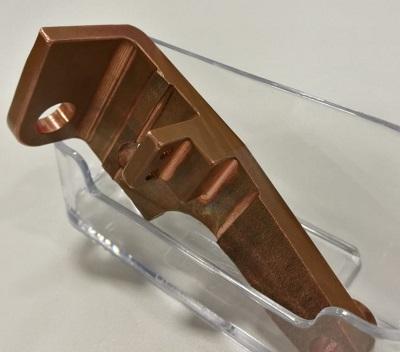- FMA
- The Fabricator
- FABTECH
- Canadian Metalworking
Cold spray now can be used as a form of 3D printing for large components
- February 17, 2020
- News Release
- Metalworking
Excerpted from a report posted to the Digital Alloys website, www.digitalalloys.com/blog/cold-spray.
Cold spray technology, which has been used for decades as a coating process, can be used as a metal additive manufacturing process to rapidly print near-net-shape parts.
Cold spray uses pressurized carrier gas to accelerate metal powders to high velocities through a de Laval nozzle aimed at the point of deposition. When the metal powder particles collide with the part’s surface, the high kinetic energy causes plastic deformation, creating mechanical interlocking and metallurgical bonding. Heat is generated during this interaction, but not enough to melt the material. This unique attribute of cold spray, referred to as a solid-state process, enables the processing of metals that are prone to crack during the rapid solidification that is characteristic of most metal AM processes. The solid-state process also allows printing in an open atmosphere without excessive oxidation.
There are two main cold spray system designs: high-pressure and low-pressure. High-pressure systems can spray powder at higher velocities (800 to 1,400 m/s versus 300 to 600 m/s in low pressure), enabling the processing of heavier, less ductile materials like steel and titanium alloys. Low-pressure systems—used to process lighter, ductile metals like aluminum and copper—can use ambient air as the propellant, whereas high-pressure systems typically require low-weight gases like nitrogen or helium. High-pressure systems are more complex and expensive to operate but can achieve higher deposition rates in production.
Used for decades as a coating process, cold spray now is being used as a form of 3D printing to build large, stand-alone components. This is accomplished by mounting the cold spray hardware on a motion-controlled gantry to direct the deposition at the part, or by fixing the nozzle and moving the part.
Cold spray uses metal powder as its primary feedstock. Similar to powder directed energy deposition and binder jetting, cold spray can use lower-cost powders than those required for powder bed fusion. However, these powders still are more expensive than most other material formats (including wire) because of their energy-intensive processing.
subscribe now


Keep up to date with the latest news, events, and technology for all things metal from our pair of monthly magazines written specifically for Canadian manufacturers!
Start Your Free Subscription- Trending Articles
Automating additive manufacturing

CTMA launches another round of Career-Ready program

Collet chuck provides accuracy in small diameter cutting

Sandvik Coromant hosts workforce development event empowering young women in manufacturing

GF Machining Solutions names managing director and head of market region North and Central Americas

- Industry Events
MME Winnipeg
- April 30, 2024
- Winnipeg, ON Canada
CTMA Economic Uncertainty: Helping You Navigate Windsor Seminar
- April 30, 2024
- Windsor, ON Canada
CTMA Economic Uncertainty: Helping You Navigate Kitchener Seminar
- May 2, 2024
- Kitchener, ON Canada
Automate 2024
- May 6 - 9, 2024
- Chicago, IL
ANCA Open House
- May 7 - 8, 2024
- Wixom, MI
















